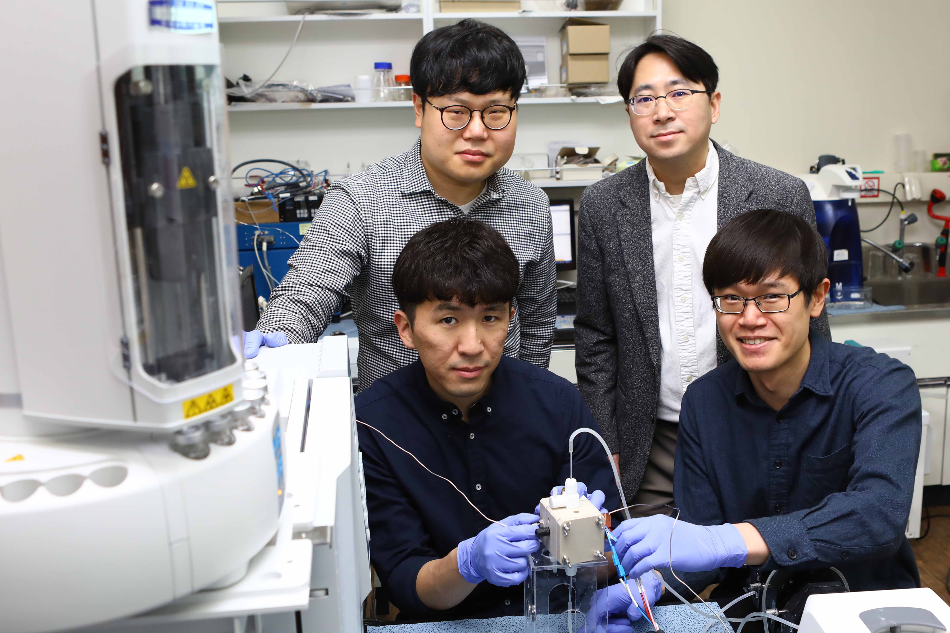Jun 4 2020
Researchers from KAIST have demonstrated three novel methods for changing local carbon dioxide (CO2) concentration in gas-diffusion electrode (GDE)-based flow electrolyzers.
 (Clockwise from back left) PhD Candidate Hakhyeon Song, Professor Jihun Oh, Dr. Ying Chuan Tan, and M.S. Candidate Kelvin Berm Lee. Image Credit: KAIST.
(Clockwise from back left) PhD Candidate Hakhyeon Song, Professor Jihun Oh, Dr. Ying Chuan Tan, and M.S. Candidate Kelvin Berm Lee. Image Credit: KAIST.
They also empirically showed that ensuring a moderate local CO2 concentration is effective in enabling carbon–carbon (C–C) coupling reactions for the synthesis of multi-carbon molecules.
This study was reported in the May 20th issue of Joule and acts as a rational guide to control CO2 mass transport for the maximum production of useful multi-carbon products.
Against the backdrop of global measures taken to decrease and recycle anthropogenic CO2 emissions, CO2 electrolysis exhibits a high potential to convert CO2 into useful chemicals that were conventionally acquired from fossil fuels.
Several studies have been making efforts to enhance CO2 selectivity for industrially and commercially high-value multi-carbon products like 1-propanol, ethanol, and ethylene as a result of their large market size and high energy density.
To realize the highly-selective conversion of CO2 into useful multi-carbon products, earlier studies have endeavored to design catalysts and tune the local surroundings associated with cations, pH, and molecular additives.
Traditional CO2 electrolytic systems heavily rely on an alkaline electrolyte that is often used up in huge quantities while reacting with CO2. Thus, they lead to an increase in operational costs. Furthermore, the short lifespan of a catalyst electrode results from its inherent chemical reactivity.
As part of their recent study, a team of researchers from KAIST led by Professor Jihun Oh from the Department of Materials Science and Engineering states that the local CO2 concentration has been a neglected factor that highly impacts the selectivity toward multi-carbon products.
In collaboration with his colleagues Dr Ying Chuan Tan, Hakhyeon Song, and Kelvin Berm Lee, Professor Oh suggested that there is a close relation between multi-carbon product selectivity and local CO2 at the time of electrochemical CO2 reduction reactions.
The researchers applied the mass-transport modeling of a GDE-based flow electrolyzer that uses copper oxide (Cu2O) nanoparticles as model catalysts. Furthermore, they found and employed three methods to modify the local CO2 concentration inside a GDE-based electrolytic system, which includes (1) feed flow rate, (2) CO2 feed concentration, and (3) control of the catalyst layer structure.
In contrast to a common notion, the study demonstrated that ensuring a maximum CO2 transport results in suboptimal multi-carbon product faradaic efficiency. Rather, by limiting and ensuring a moderate local CO2 concentration, C–C coupling can be improved considerably.
The scientists experimentally illustrated that the selectivity rate improved from 25.4% to 61.9%, and from 5.9% to 22.6% for the conversion rate of CO2. When a cost-effective, milder, near-neutral electrolyte was employed, the CO2 electrolytic system’s stability increased considerably, enabling over 10 hours of stable selective production of multi-carbon products.
According to Dr. Tan, “Our research clearly revealed that the optimization of the local CO2 concentration is the key to maximizing the efficiency of converting CO2 into high-value multi-carbon products.”
Tan is also the lead author of the paper.
This finding is expected to deliver new insights to the research community that variables affecting local CO2 concentration are also influential factors in the electrochemical CO2 reduction reaction performance. My colleagues and I hope that our study becomes a cornerstone for related technologies and their industrial applications.
Jihun Oh, PhD, Associate Professor, Department of Materials Science and Engineering, KAIST
This work was financially supported by the Korean Ministry of Science and ICT (MSIT) Creative Materials Discovery Program.
Journal Reference:
Tan, Y. C., et al. (2020) Modulating Local CO2 Concentration as a General Strategy for Enhancing C–C Coupling in CO2 Electroreduction. Joule. doi.org/10.1016/j.joule.2020.03.013.